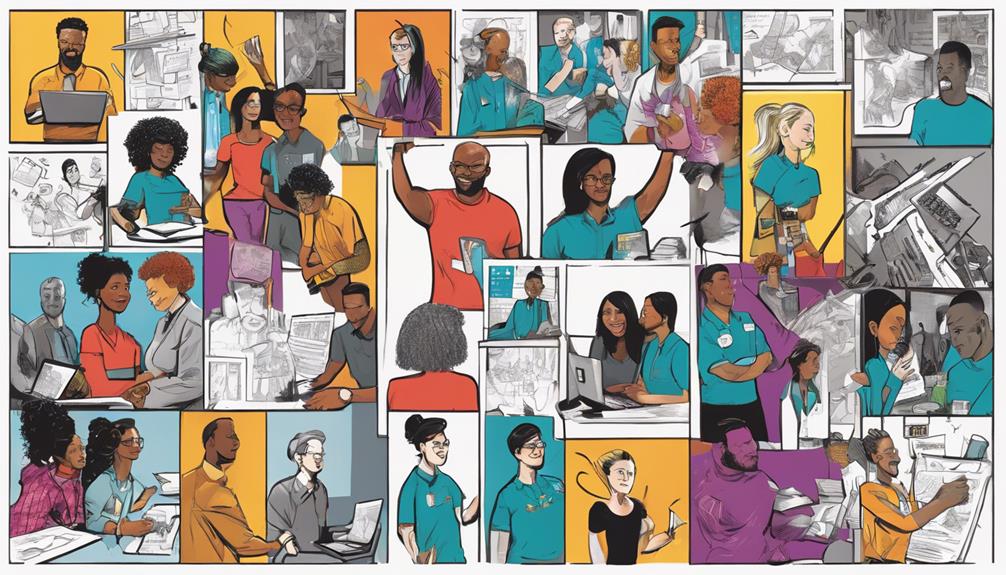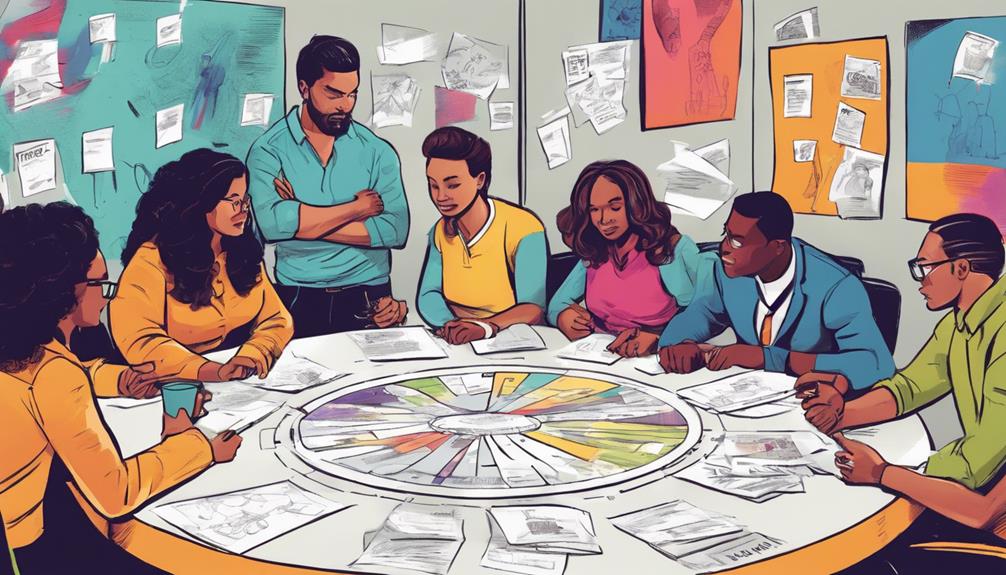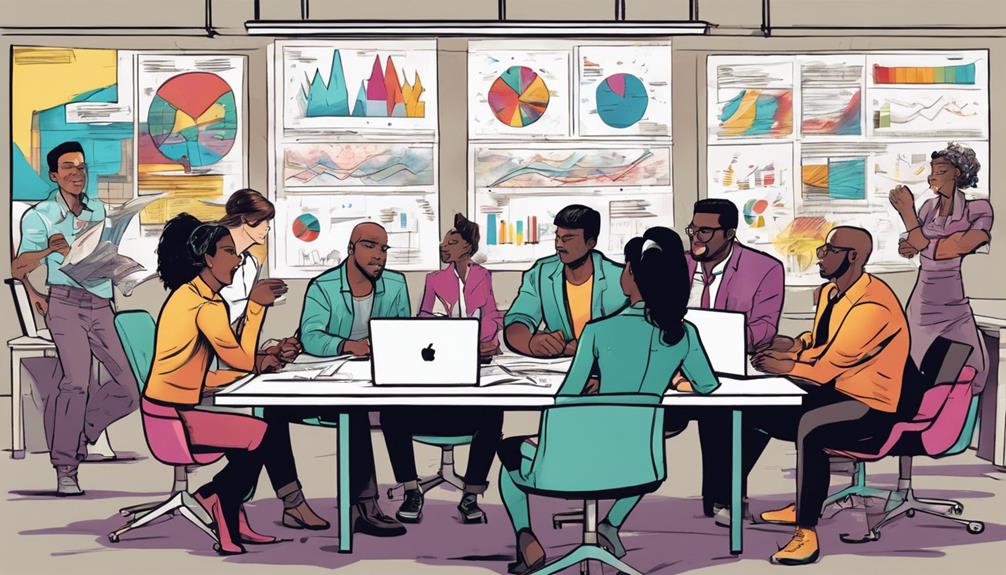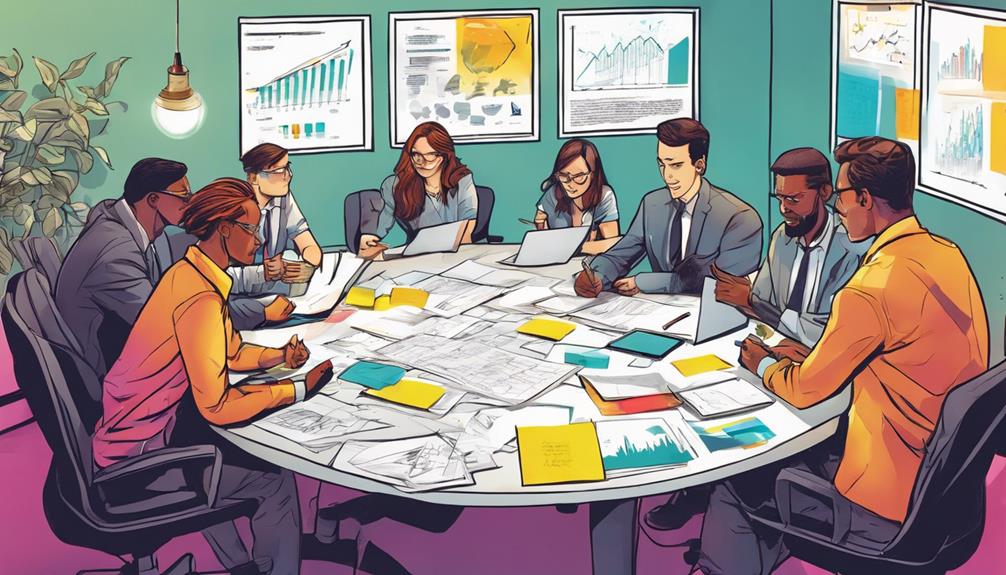Using StrengthsFinder in your business can significantly unlock your team’s potential. By identifying individual strengths across four key domains—Executing, Influencing, Relationship Building, and Strategic Thinking—you can improve collaboration and productivity. Teams that leverage their strengths experience engagement boosts of 7% to 23% and productivity increases of 8% to 18%. Start by facilitating the CliftonStrengths assessment and organizing discussions to promote understanding. Regular check-ins help align strengths with roles, building trust and unity. When everyone is aware of their strengths, challenges can be seen as opportunities for growth. There is much more to discover about enhancing your team’s effectiveness with this approach.
Key Takeaways
- Implement the CliftonStrengths assessment to identify and leverage individual strengths within your team for enhanced performance.
- Regularly facilitate strengths-based discussions to foster trust, collaboration, and a sense of belonging among team members.
- Align roles with team members' strengths to improve productivity by 8%-18% and reduce attrition rates by 20%-73%.
- Engage in practical team-building activities like strengths mapping and compliment exchanges to appreciate diverse talents.
Understanding StrengthsFinder Framework
The CliftonStrengths framework helps you pinpoint your unique talents by categorizing strengths into four key domains: Executing, Influencing, Relationship Building, and Strategic Thinking. This strengths-based approach focuses on identifying and maximizing your individual strengths rather than dwelling on weaknesses. By understanding where you excel, you can contribute more effectively to your team and organization.
In the Relationship Building domain, you'll find strengths that foster trust and collaboration. These strengths are essential in creating a supportive environment where team members feel valued and connected. When you recognize your Relationship Building talents, you can leverage them to enhance communication and cooperation among colleagues.
Engaging in regular discussions about these strengths within your team not only promotes transparency but also encourages everyone to appreciate each other's unique contributions. This open dialogue can lead to improved team dynamics, as members learn how to work together more effectively.
Benefits of Leveraging Strengths

When you leverage individual strengths, you boost engagement and productivity across your team.
This focus not only enhances collaboration but also fosters a sense of unity and purpose among team members.
Increased Engagement and Productivity
Leveraging individual strengths can greatly boost engagement and productivity, creating a more motivated and effective workforce. When you focus on employees' unique talents, you're likely to see a significant increase in engagement levels. Studies show teams utilizing CliftonStrengths experience 7%-23% higher employee engagement, which can directly enhance overall productivity.
Here's a quick overview of the benefits you can expect:
| Benefit | Impact |
|---|---|
| Increased Engagement | 7%-23% higher |
| Enhanced Productivity | 8%-18% improvement |
| Decreased Attrition Rates | 20%-73% reduction |
Enhanced Team Collaboration
Fostering enhanced team collaboration becomes a natural outcome when you focus on individual strengths, as it creates a shared understanding among team members and improves communication. When you adopt a strengths-based approach, you'll find that everyone speaks the same language regarding their capabilities. This common vocabulary facilitates smoother interactions and encourages team members to engage more openly.
Aligning roles with individual strengths not only boosts energy but also greatly impacts team performance. Research shows that teams actively participating in strengths-based development initiatives can see performance improvements of 8%-18%. Additionally, by recognizing and utilizing each member's unique strengths, you enhance overall team dynamics and productivity.
Moreover, this focus on strengths can also lead to lower attrition rates—between 20%-73%. When people feel valued for their contributions, they're more likely to stay, resulting in a stronger, more cohesive team. The result is a collaborative environment where creativity flourishes and problem-solving becomes more effective.
Key Traits in Each Domain

Understanding the key traits in each domain of StrengthsFinder can greatly enhance your team's effectiveness and collaboration. Each domain offers unique strengths that can be leveraged to create a strengths-based environment.
In the Executing Domain, traits like Achiever and Arranger drive productivity, ensuring that tasks are completed efficiently. Team members with these traits can help keep projects on track and organized.
The Influencing Domain features individuals such as Activators and those skilled in Communication, motivating and engaging your team. These traits are vital for driving action and ensuring that everyone is aligned with team objectives.
In the Relationship Building Domain, Empathy and Developer traits shine. These individuals foster strong connections and develop the potential of team members, creating a supportive atmosphere that encourages growth.
Implementing StrengthsFinder in Teams

To effectively implement StrengthsFinder in teams, it's vital to first gain buy-in from all members, ensuring everyone feels invested in the process.
Start by facilitating the CliftonStrengths assessment, which provides valuable insights into each member's unique strengths. This lays the groundwork for improved collaboration, helping your team work together more effectively.
Once everyone has their results, organize a debriefing session in a safe environment. This encourages open discussions about teams' strengths and fosters mutual respect among team members.
Make sure to integrate these insights into task assignments, aligning roles with individual strengths. This strengths-based approach can lead to a performance increase of 8%-18%, enhancing overall productivity.
Regular check-ins and reflection sessions are vital for maintaining alignment and adaptability within the team. These sessions should focus on how team members are utilizing their strengths in daily tasks.
By reinforcing a culture of continuous development, you empower your team to thrive, making the most of their unique capabilities.
Building Trust Through Strengths

Building trust among team members becomes easier when everyone shares their strengths and appreciates what each person brings to the table. When you hold strengths-based sessions, you create a supportive atmosphere where open discussions about individual and collective strengths flourish. This understanding fosters collaboration and enhances communication, leading to a more cohesive team environment.
Regularly integrating conversations about strengths into your daily routines promotes a culture of trust and stability. By continuously engaging with and acknowledging each other's contributions, you reinforce a sense of belonging within the team. As a leader, prioritizing strengths recognition is essential; it contributes to psychological safety, allowing team members to feel valued and secure in expressing their ideas and concerns.
Moreover, understanding individual strengths helps your team adapt during shifts, reinforcing trust and stability. When members recognize and appreciate each other's unique capabilities, they become more resilient and supportive of one another.
In this strengths-based approach, you not only build trust but also create a dynamic environment where everyone can thrive, ultimately enhancing your team's collaboration and effectiveness.
Enhancing Team Performance

Leveraging individual strengths within your team can greatly enhance performance and drive productivity. By focusing on a strengths-based approach, you can reveal your team's potential and create a more dynamic work environment.
Here are four key benefits of enhancing team performance through strengths:
- Increased Engagement: Teams utilizing CliftonStrengths report 7%-23% higher employee engagement, leading to improved morale.
- Better Role Alignment: Strengths-based development can boost performance by 8%-18% as members align with roles that suit their natural talents.
- Stronger Dynamics: Understanding individual strengths fosters teamwork, enhancing collaboration and communication among members.
- Higher Retention: Organizations prioritizing strengths see attrition rates drop by 20%-73%, indicating improved job satisfaction.
Practical Team Building Activities

When it comes to building a strong team, focusing on individual strengths can make all the difference.
You can kick things off with strengths-based icebreakers, explore role-reversal exercises, and engage in collaborative strengths mapping sessions.
These activities not only boost engagement but also enhance teamwork and creativity.
Strengths-Based Icebreaker Activities
Strengths-based icebreaker activities frequently enhance team dynamics by encouraging members to openly share their unique abilities. When you engage in these activities, you foster a culture of collaboration and respect within your teams.
Here are four effective strengths-based icebreaker activities to try:
- Strengths Sharing Circle: Each team member shares their top three strengths and how they can contribute to the team's goals.
- Strengths Mapping: Create a visual map of everyone's strengths, allowing you to identify complementary skills and collaboration opportunities.
- Compliment Exchange: Pair up team members to exchange genuine compliments focused on each other's strengths, promoting appreciation and connection.
- Strengths-Based Trivia: Design a fun trivia game where team members guess each other's strengths based on clues, enhancing knowledge of one another.
Engaging in these activities can increase team engagement by up to 23%. By regularly incorporating strengths-based icebreakers, you not only improve communication but also contribute to a positive workplace culture, considerably lowering attrition rates in your teams.
Embrace these activities to reveal your team's potential!
Role-Reversal Strengths Exercises
Role-reversal strengths exercises allow team members to step into each other's shoes, fostering empathy and a deeper appreciation for each other's unique contributions. By switching roles, you can uncover hidden talents and enhance your team's dynamics, all while aligning with the strengths framework.
Here's a simple table to help you visualize the benefits of role-reversal exercises:
| Activity | Benefits |
|---|---|
| Role-Switching Sessions | Increases understanding of colleagues' challenges |
| Strengths Reflection | Identifies hidden talents within the team |
| Feedback Discussions | Enhances communication and builds trust |
Implementing these activities during team-building sessions can notably boost engagement and collaboration. You'll find that participants often report improved teamwork and a greater appreciation of how individual strengths complement one another. Regularly incorporating role-reversal strengths exercises not only sustains a culture of appreciation but also encourages continuous growth within your organization. So why not give it a try? You'll likely discover new ways to harness the strengths of your team, leading to a more cohesive and productive work environment.
Collaborative Strengths Mapping Sessions
Collaborative strengths mapping sessions provide a dynamic way for teams to visually identify and leverage each member's unique talents, enhancing overall performance and collaboration.
By engaging in these sessions, you'll uncover opportunities that can transform your team's dynamics. Here are four key benefits of collaborative strengths mapping:
- Identify Team Members' Strengths: Everyone gets to showcase their unique talents, fostering a culture of appreciation.
- Gap Analysis: You can pinpoint gaps in strengths, guiding targeted development or recruitment to bolster team performance.
- Open Communication: These sessions promote understanding and facilitate conflict resolution, leading to a harmonious work environment.
- Boost Engagement: Research shows that teams utilizing strengths mapping report performance increases ranging from 8% to 18%, resulting in higher engagement levels.
Measuring Impact and Growth

Measuring the impact of CliftonStrengths in your business reveals significant gains in employee engagement and productivity. When you focus on the unique strengths of individuals and teams, you'll see how effective it can be in enhancing the work done. The benefits are clear, showcasing a strong correlation between leveraging members' strengths and overall team performance.
Here's a quick overview of the measurable impacts:
| Metrics | Engagement Improvement | Productivity Increase |
|---|---|---|
| Employee Engagement | 7% – 23% | |
| Productivity | 8% – 18% | |
| Attrition Rate Reduction | 20% – 73% | |
| Team Collaboration Increase | Improved Dynamics | |
| Long-term Resilience | Enhanced Outcomes |
Future of Strengths in Leadership

As you look ahead, embracing strengths-based leadership will be key to steering the evolving landscape of team dynamics and organizational success. The potential of your team can be revealed through a focused approach that nurtures individual strengths.
Here are four reasons why strengths-based leadership is essential for the future:
- Increased Engagement: Teams that leverage strengths experience 7%-23% higher employee engagement.
- Enhanced Performance: Organizations adopting this approach see an 8%-18% improvement in overall performance.
- Reduced Turnover: Aligning roles with individual talents can cut turnover rates by 20%-73%.
- Fostering Trust: Prioritizing strengths helps managers cultivate an environment of trust and stability, driving collaboration and innovation.
As leaders, you must commit to continuous learning and development of strengths, integrating coaching and feedback into your practice. This approach not only boosts team morale but also creates a positive organizational culture.
Conclusion
By embracing the StrengthsFinder framework, you're not just releasing individual potential but also enhancing your team's overall performance.
Did you know that teams that focus on strengths are 12.5% more productive? This statistic highlights the significant impact of leveraging strengths in the workplace.
As you implement these strategies, remember that building trust and fostering collaboration will lead to a more engaged and successful team.
Start today, and watch your team thrive like never before!









